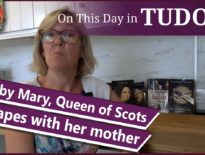On this day in Tudor history, 24th July 1553, merchant and conspirator Richard Hesketh was born in Lancashire. Hesketh is known for the Hesketh Plot of 1593, when he urged Ferdinando Stanley, 5th Earl of Derby, to lead a rebellion to claim the throne of England.
But who was Richard Hesketh and why did he plot against Queen Elizabeth I? What happened to him and what happened to Ferdinando Stanley? And why did Stanley take bezoar stone and uncorn horn?
Find out all about Hesketh, his background, his plot, and the aftermath in today's talk.
Also on this day in Tudor history, 24th July 1567, twenty-four-year-old Mary, Queen of Scots, who was imprisoned at Lochleven Castle, and who was recovering after miscarrying twins, was threatened with violence and forced to abdicate. Her young son, James, became King James VI of Scotland in her place. Find out more about what happened in last year’s video:
Also on this day in history:
- 1534 – Jacques Cartier, the French explorer, landed in Canada, at Gaspé Bay in Quebec, and claimed it for France by placing a cross there.
- 1594 – John Boste, Roman Catholic priest and martyr, was hanged, drawn and quartered in Durham after being accused of leaving and re-entering England without permission. He was canonized in 1970 by Pope Paul VI.
Transcript:
On this day in Tudor history, 24th July 1553, merchant and conspirator Richard Hesketh was born in Lancashire. Hesketh is known for the Hesketh Plot of 1593, when he urged Ferdinando Stanley, 5th Earl of Derby, to lead a rebellion to claim the throne of England.
Let me tell you a bit more about Richard Hesketh and his plot…
Richard Hesketh was the fourth son of landowner Gabriel Hesketh, who was from Aughton New Hall in Lancashire, and his first wife, Jane Halsall. Hesketh was apprenticed to a man called Hugh Fayreclough and became a freeman of the Clothworkers’ Company in London in 1578, when he was 25. He was mentioned by John Dee in his diary in 1581 as a friend and agent in Antwerp who, while exporting cloth, also carried letters from Dee to his contacts in Antwerp and who searched for books for him.
Hesketh married widow Isabel Shaw in around 1586. In 1589, he was forced into exile for three years following his involvement in a riot near Preston which caused the death of two men. While in exile in Prague, he joined the circle of alchemist Edward Kelley and was protected from trouble when Kelley fell from favour in 1591 by Jesuit Thomas Stephenson. A year later, he was working in intelligence for Sir William Stanley in Flanders, who was there fighting for Spain and who was supporting the claim of Henry Stanley, 4th Earl of Derby to the throne of England. Hesketh returned to England in the summer of 1593 and in September 1593 he travelled to Lathom House, home of the Stanleys. Henry Stanley died that very day and his son, Ferdinando, became the 5th Earl of Derby. Ferdinando had a claim to the throne as his mother was Lady Margaret Clifford, granddaughter of Charles Brandon, Duke of Suffolk, and Mary Tudor, Queen of France, sister of King Henry VIII. Hesketh put forward the idea that Ferdinando should lead a revolt against Elizabeth I and claim the throne. Ferdinando had two meetings with Hesketh regarding Hesketh’s plot, but when Hesketh joined him on his journey to the royal court at Windsor, Ferdinando took him as prisoner and turned him over to the queen’s privy council.
Hesketh was interrogated at Ditton House, near Windsor Castle, and on 15th October 1593 Hesketh confessed to the plot. On 24th November, he was tried for treason at St Albans, as London was affected by an outbreak of plague, his trial being presided over by Sir Thomas Egerton, attorney general. Hesketh was found guilty and executed on 29th November 1593, denying his Catholic faith.
On 5th April 1594, Ferdinando was suddenly taken ill, vomiting violently, his vomit being described as the colour of “soot or rusty iron”. Ferdinando believed that he had been bewitched and others claimed that he had been poisoned. He took all kinds of medicines, including bezoar stone and unicorn’s horn, but nothing worked. He died on 16th April 1594.



Hi, I am a genealogist and believe Richard Hesketh may be a relation. Is there a site that would show me his children or more about his family? All I can find is to do with the Plot to depose Elizabeth l. Any direction/ help would be gratefully received. I do have links back to 1569 but I am reluctant to go any further without Corroboration. Kind Regards Bernadette Hampson
Bernadette, you might find this PhD Thesis helpful, especially if you look for the sources used for the Hesketh details.
https://oro.open.ac.uk/78595/1/Chris%20Mains%20%20History%20Doctoral%20Thesis.pdf